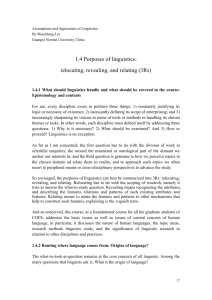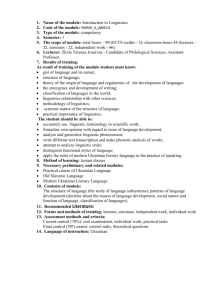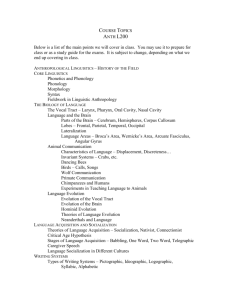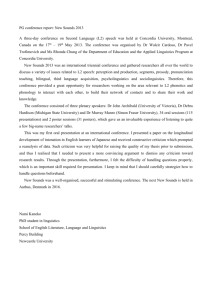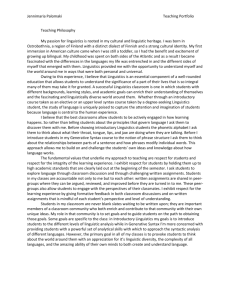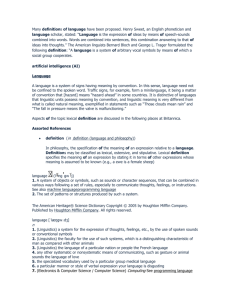Animal & Human Language: Properties & Communication
advertisement
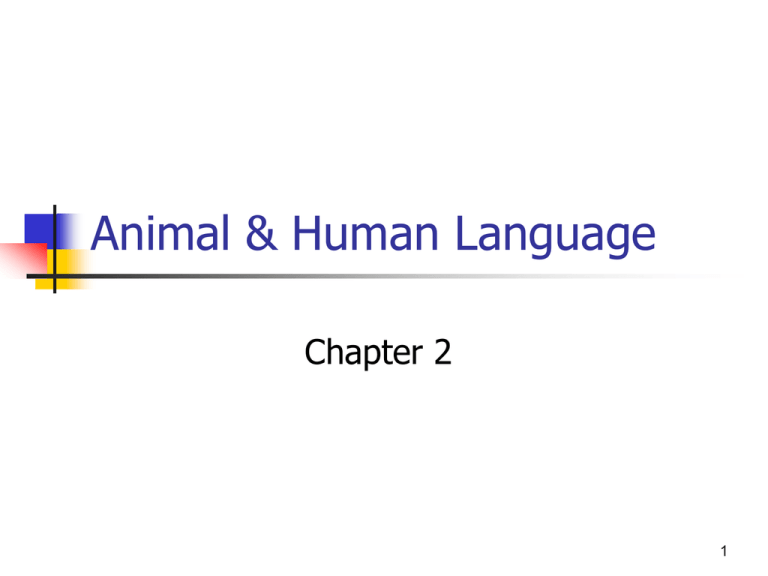
Animal & Human Language Chapter 2 1 What is Linguistics? It is the scientific study of human language. Scientific (empirical/theoretical) 2 Language? How do languages work? Are there rules? What are these rules? What do we know when we know a language? Linguistics- Internal Knowledge of Language. Knowledge of sound system Knowledge of words Knowledge of sentence 3 Scientific? Linguistics is a scientific discipline with established theories, analytic methods, and real-world applications. The primary object of linguistic study is human language, not language in other extended senses (e.g. body language). 4 Main branches Phonetics Phonology Morphology Syntax Semantics Pragmatics 5 Other Branches Sociolinguistics Applied Linguistics Psycholinguistics Computational Linguistics 6 Important questions Each and every human language can express any thought the human mind can devise. Is it possible that a creature may learn to communicate with humans using language? Does human language have special properties that make it unique and different than any other communication systems found in nature? 7 The Properties of Human Language Unique system of communication Informative signals: signals which you have not intentionally sent body language Communicative signals: signals you use intentionally to communicate something 8 Properties of human language • Displacement Human language refers to the past, present and future- last night, at school, I’m flying to Paris next week • Things that do not exist in real life, e.g. superman, batman, Santa Claus • • Animal communication- immediate moment Bee language: dance routine to communicate the location of nectar 9 Properties of human language Arbitrariness no natural connection between a linguistic form and its meaning= arbitrary relationship Dog in English and كلبin Arabic. In animal communication- a connection between the message and the signal used to convey the message. Consists of a fixed and limited set of vocal forms 10 Properties of human language o o o o Productivity Humans are capable of creating new expressions for new objects- infinite a language user can manipulate his linguistic resources open endedness Animals have limited set of signals to choose from- fixed reference Cannot produce any new signals to describe novel experiences. 11 Properties of human language Cultural transmission We acquire language with other speakers not from parental genes The first language is acquired in a culture A Korean child living in USA. Animal communicative signals are produced instinctively. 12 Properties of human language o o o Duality Two levels: distinct sound & distinct meaning Physical level at which we can produce individual sounds e.g. n, b, i. Meaning level: when we produce sounds in combination e.g.: nib, bin Economical feature Animal communicative signals are fixed and cannot be broken into parts- meow is not m+e+o+w 13 Other properties Vocal-auditory channel Specialization Non-directionality Rapid fade Reciprocity Prevarication 14 Talking to animals Is language the exclusive property of human beings? Are the communication systems used by other creatures at all like human linguistic knowledge? 15 Chimpanzees and language Some researchers devoted their time to teach a chimpanzee how to use human language- not successful o 1930s Gua- was able to understand 100 words but did not produce any o o 1940s Viki- produced poorly articulated versions of mama, papa, and cup Result non-human primates lack a physically structured vocal tract needed to produce sounds 16 Talking to animal Washoe Use a version of American Sign Language Raised like a human After 3 and half years came to use more than 100 words Airplane, baby, banana Combine them to produce sentences More fruit 17 Talking to animals Sarah and Lana They both use word symbols Use a set of plastic shapes that represent words to communicate with humans Trained to associate shapes with objects or actions Was capable of producing sentences Mary give chocolate Sarah 18 The controversy Can animals speak human-like languages? NO Terrace argues researchers overinterpreted their results Animals produce a particular behavior in response to a particular stimulus or ‘noise’, but do not actually understand what the words mean. 19 Kanzi Learned the symbols not by being taught but by being exposed to it in an early age. Were those chimpanzees capable of taking part in interactions by using symbols chosen by humans and not chimpanzees? Did they perform linguistically on a level of a child their age? Humans possess a natural, inborn facility to be creative with symbols; as far as we know, animals do not. 20


